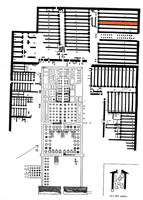
In 1896 Petrie and Quibell uncovered a late Middle Kingdom shaft tomb beneath the later store-rooms of the tempe to the cult of Ramesses II on the West Bank of the Nile at Thebes, the Ramesseum.
 |
Plan of the Ramesseum. The area of the late Middle Kingdom tomb is marked red (click on the image for a larger picture) |
Although the coffin of the original occupant of the tomb did not survive, the excavators found a box full of fragile manuscripts. After conservation by Hugo Ibscher in Berlin, the manuscripts were listed by Alan Gardiner as follows (Gardiner 1955):
A. the Tale of Khuninpu ('Eloquent Peasant') on one side, Tale of Sanehat ('Sinuhe') on other side (Berlin 10499)
B. copy of a ritual for a statue of Senusret I ('Dramatic Ramesseum Papyrus') (British Museum)
C. copy of administrative despatches from fortresses in Nubia on one side ('Semna despatches'), incantations for good health on other (British Museum)
D. copy of wordlist ('Onomasticon') (Berlin 10495)
E. copy of a funerary ritual (British Museum)
With the exception of Papyri A and D, in Berlin, the collection is now preserved in the British Museum. The division into different numbers for the incantations for good health requires reexamination; it is possible that some manuscript fragments might join to form longer rolls.
For the objects found around the box, see Quibell 1898: 3 and pl.3. The box in which the manuscripts were found has not been identified in any museum receiving a share in finds; it is described by Quibell in the following terms:
'a wooden box about 18x12x12 inches. It was covered with white plaster, and on the lid was roughly drawn in black ink the figure of a jackal'.
Beside the papyri, the box contained 'also a bundle of reed pens, 16 inches long and a tenth of an inch in diameter'.
Copyright © 2003 University College London. All rights reserved.